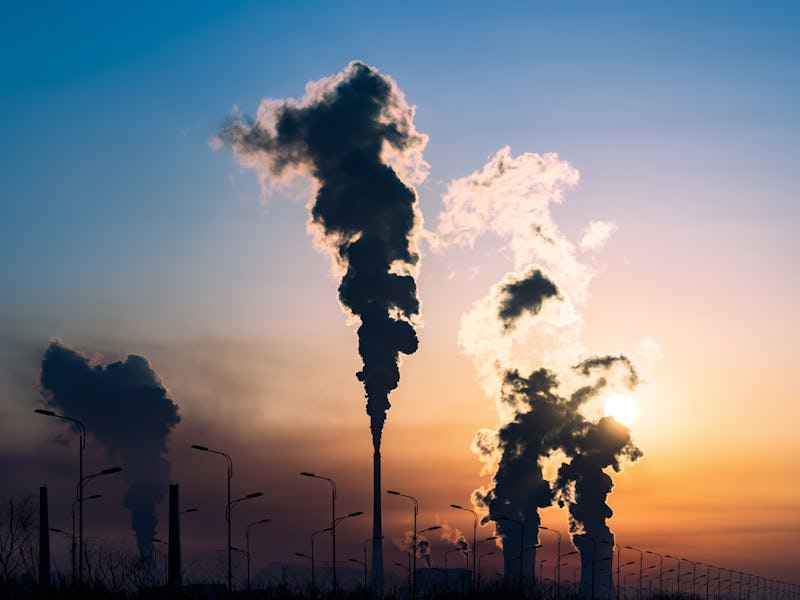We might exceed this major climate tipping point in nine years
There's a 50 percent chance we'll surpass 1.5 degrees Celsius in the next nine years.

Due to pandemic-related lockdowns and the slowdown of the international economy, carbon emissions plummeted worldwide in 2020, providing a temporary reprieve from our alarming upward trajectory of global warming.
Unfortunately, as the world resumed pre-pandemic activity, that decline sharply reversed last year with no end in sight to the climbing emissions in 2022, according to a new report published on Thursday by the Global Carbon Project, which releases annual reports on global carbon emissions.
The report reveals the world’s key emitting countries are not curbing emissions adequately to keep temperatures from rising above 1.5 degrees Celsius — a key climate benchmark agreed upon in the landmark Paris Agreement.
Here’s everything you need to know from this crucial report.
The big takeaways
1. In 2021, global emissions increased by five percent compared to 2020, equaling pre-pandemic levels.
Carbon emissions — key drivers of global warming — are projected to increase by one percent in 2022 to 40.6 gigatons (40.6 billion tons). In other words: Emissions are now slightly above 2019 levels, reversing any temporary gains from the pandemic.
2. The global concentration of carbon dioxide increased by more than 50 percent between 1750 and 2022.
This corresponds significantly with a rise in emissions from fossil fuels like oil, coal, and natural gas in the twentieth century. More than 60 percent of fossil fuel emissions have occurred since 1990 — a relatively short time period.
3. A handful of countries and regions are generating the lion’s share of the world’s emissions.
The report states that China, India, the EU, the U.S., Russia, and Japan emitted roughly 67 percent of carbon emissions. China and the U.S. are the worst offenders, accounting for 31 percent and 14 percent, respectively. Historically, the U.S. is the single worst emitter, but China has been catching up as its emissions have increased by 1.5 percent annually for the last decade. An interactive world map created by the Global Carbon Project shows emissions by country and region.
A figure from the study shows skyrocketing atmospheric levels of carbon dioxide from 1960 to the present.
The report suggests China’s emissions are actually projected to decline 0.9 percent due to a slowdown in the housing market and continuing Covid-19 lockdowns, while emissions in the U.S. are projected to increase by 1.5 percent. In terms of other big players, India’s emissions are set to increase by six percent while emissions in the EU will drop by 0.8 percent — even as the demand for coal has temporarily increased due to Russia’s war in Ukraine.
4. Coal — the most polluting fossil fuel by far — still reigns supreme globally, totaling 40 percent of fossil fuel emissions.
But the report suggests demand for coal will gradually continue to drop, while oil and gas rebound. Oil and gas came in second and third place, accounting for 32 and 21 percent, respectively. Renewable energy technology is accelerating, especially in the EU and the U.S., but it’s not growing fast enough to replace consumption from fossil fuels.
5. Just three countries — Brazil, Indonesia, and the Democratic Republic of the Congo — contribute 58 percent of emissions from land use.
While carbon emissions from land use — agriculture and deforestation as opposed to fossil fuels — did not increase in recent years, the burning of the Amazon and forests in Southeast Asia for cattle grazing and palm oil remain a significant source of global emissions.
6. The world’s opportunity to curb global warming to 1.5 degrees Celsius is quickly narrowing.
We now have a 50 percent chance of surpassing 1.5. degrees of warming in the next nine years. This is our best method for preventing more severe effects of global warming, like more frequent natural disasters.
Why the report matters – If we want to achieve net-zero carbon emissions by 2050 — the goal of President Joe Biden and many other world leaders — we’ll need to continually reduce emissions each year — a difficult feat given that sharp drops in emissions typically only occur due to global economic crises like the late 2000s recession or the Covid-19 pandemic.
There is some reason to be hopeful: The report indicates that the growth rate of fossil fuel emissions has slowed to 0.3 percent from a high of 3 percent and higher in the 2000s. But it’s still not enough to limit global warming to the levels we need to avoid the worsening effects of the climate crisis.
A map from The Global Carbon Project shows emissions by country, with India, China and the U.S. leading the way in global emissions.
As world leaders gather at the UN’s annual climate change conference, COP27, in Egypt, the report’s message is loud and clear: We need bold and decisive action to halt global warming now. UN Secretary-General Antonio Guterres said net-zero pledges made at COP27 must “be in line with IPCC scenarios limiting warming to 1.5 degrees” and warned that our current global warming trajectory is a “highway to climate hell.”
“There are some positive signs, but leaders meeting at COP27 will have to take meaningful action if we are to have any chance of limiting global warming close to 1.5°C,” Pierre Friedlingstein, lead author of the report from Exeter's Global Systems Institute, said in a press release.
What’s next — The study authors suggest that we can still clamp down on emissions and avert further climate catastrophe by rapidly amping up clean energy technology and increasing tree-planting efforts.
"We are at a turning point and must not allow world events to distract us from the urgent and sustained need to cut our emissions to stabilize the global climate and reduce cascading risks,” said co-author Corinne Le Quéré, Royal Society Research Professor at UEA’s School of Environmental Sciences.
This article was originally published on